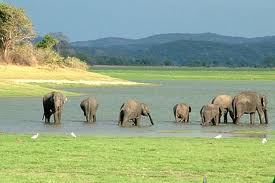 Minneriya National Park National park is in an
uninhabited area of the country’s most diverse natural systems, with
intermediate forests, Bamboo stands, patanas and platoes. The tank within the
park supports a variety of waterfowl while being of immense socio-economic
value.
Minneriya National Park National park is in an
uninhabited area of the country’s most diverse natural systems, with
intermediate forests, Bamboo stands, patanas and platoes. The tank within the
park supports a variety of waterfowl while being of immense socio-economic
value.
 Stratification: Dry monsoon forest, tanks &
grass lands
Stratification: Dry monsoon forest, tanks &
grass landsSize: 2,550ha
Status: National Park
Altitude: 100m
Temperature: Average 27.5 (Degree C)
Annual Rainfall: Average 1,150mm
Best time of year to visit: May to October for the 'Gathering' of Elephants
Optimum duration of stay: Minimum of 1 night
Accommodation Options: Deer Park, Chaaya Village, Cinnamon Lodge, Heritance Kandalama, Luxury camping
Highlands: The largest known 'Gathering' of Asian Elephants in the world occurs from May to October each year in Minneriya National Park







